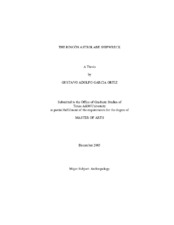| dc.description.abstract | On 30 December 1986, a local fisherman incidentally discovered the remains of a
seventeenth-century merchantman off the coast of Rincon, a small municipality on
Puerto Rico's west coast. Some days later, he and some acquaintances extracted objects
from the site and stored them in a nearby restaurant. The assemblage of artifacts
recovered included, among other items, pins, scissors, ordnance, pewter ware,
woodworking tools, a myriad of concretions and a nautical astrolabe. It is from the last
that the wreck site took its name. The operation continued for months until local
authorities, alerted by a member of the salvage group, issued a cease and desist order.
At that point, the whole affair entered a legal process that on the summer of 2005 had
not reached its conclusion.
The purpose of this thesis is twofold. First, the author presents the story of the
shipwreck from the moment it was found until the court ruled regarding ownership of
the artifacts. Since this was the first time ownership of a shipwreck was debated in
Puerto Rican courts in recent history, this gives the reader an idea of how legal
precedence was established concerning the island's submerged cultural resources.
Second, based on what was popularly perceived to be the site's most remarkable find, a
study was developed on the sea or mariner's astrolabe, a navigation instrument that played a fundamental role in the process of European maritime expansion during the late
fifteenth, sixteenth and seventeenth centuries.
The reader of this text will learn that, during the fifteenth century, Portuguese
navigators saw the need to gradually depart from the traditional Mediterranean
navigation technique known as "dead reckoning." As their explorations along the West
African coast forced them to sail far into the Atlantic Ocean for prolonged periods, a
new method was developed that consisted of measuring the angle of certain heavenly
bodies above the horizon in order to determine the latitude of the observer with
reasonable precision. For this purpose, instruments that traditionally belonged to the
field of astronomy were adapted to be used by seamen. Among them was the astrolabe,
which became the most popular by the turn of the sixteenth century. After discussing
the instrument's origin and development, the author analyzes how a renewed interest on
the nautical astrolabe, which emerged in Portugal in the early twentieth century,
introduced the instrument to the field of modern scholarly research. This work also
presents a catalogue of sixteen sea astrolabes, some of which have never been published.
The catalogue shows statistics and other relevant information, while placing the artifacts
in the context of the previously existing data. | en |


